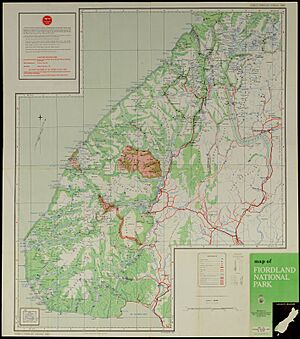List of sounds and inlets of Fiordland facts for kids
Welcome to Fiordland, a stunning part of southwestern New Zealand! This area is famous for its incredible natural beauty. It has many long, narrow waterways that stretch inland from the sea. These are often called sounds or inlets. They make the coast look like a puzzle piece, full of hidden corners and amazing views.
Contents
Exploring Fiordland's Amazing Waterways
Fiordland is a special place known for its deep, water-filled valleys. These valleys were carved by glaciers thousands of years ago. When the glaciers melted, the sea filled these valleys, creating what we see today.
What are Fiords, Sounds, and Inlets?
You might hear words like "fiord," "sound," and "inlet." They can be a bit confusing!
- A fiord is a long, narrow sea inlet. It is usually steep-sided and was formed by a glacier.
- A sound is a large sea or ocean inlet. It is often wider than a fiord. Sometimes, people use "sound" to describe a fiord in New Zealand.
- An inlet is a small arm of the sea, a lake, or a river. It usually extends inland.
In Fiordland, many of these waterways are actually fiords, even if they are called "sounds." They are all beautiful places to explore!
A Journey Along the Coast
Let's take a trip down the coast of Fiordland. We will start in the north and head south. Along the way, we will discover many unique waterways. Each one has its own special features and stories.
North to South: The Waterways of Fiordland
Here is a list of the main sounds and inlets you can find in Fiordland, moving from the top to the bottom of the map:
- Big Bay
- Martins Bay
- Milford Sound: One of the most famous fiords in the world!
- Poison Bay
- Sutherland Sound
- Hāwea / Bligh Sound: This sound has a smaller arm called Bounty Haven.
- Bounty Haven
- George Sound: Look for its South West Arm.
- South West Arm
- Looking Glass Bay
- Caswell Sound
- Charles Sound: It includes a section known as Emelius Arm.
- Emelius Arm
- Hinenui / Nancy Sound: This sound has a part called Foot Arm.
- Foot Arm
- Thompson Sound: This leads to Bradshaw Sound.
- Bradshaw Sound: Also sometimes called Doubtful Sound.
- Precipice Cove
- Gaer Arm
- Bradshaw Sound: Also sometimes called Doubtful Sound.
- Doubtful Sound / Patea: A very large and impressive fiord with several arms:
- Malaspina Reach
- Hall Arm
- Crooked Arm
- First Arm
- Malaspina Reach
- Dagg Sound: It has an arm called Anchorage Arm.
- Anchorage Arm
- Breaksea Sound: This sound has two main arms:
- Vancouver Arm
- Broughton Arm
- Acheron Passage: This passage links Breaksea Sound to Dusky Sound.
- Wet Jacket Arm
- Tamatea / Dusky Sound: A historic and large sound with several coves and bays:
- Supper Cove
- Fanny Bay
- Cascade Cove
- Taiari / Chalky Inlet: This inlet has two important arms:
- Moana-whenua-pōuri / Edwardson Sound
- Te Korowhakaunu / Kanáris Sound
- Rakituma / Preservation Inlet: This inlet also has several arms and bays:
- Isthmus Sound
- Useless Bay
- Te Awaroa / Long Sound
- Lake Hakapoua: This lake was once connected to the sea. A landslide in 1915 separated it.
Why Dual Names?
You might have noticed that some of these places have two names. For example, Hāwea / Bligh Sound. These are called dual names. In 2019, many of these sounds and inlets were given these dual names. This often includes a Māori name and an English name. It helps to recognize both the rich Māori history and the European exploration of the area.


